#maxim gorki theater
Text

Maxim Gorki Theater, Dantons Tod / Iphigenie
„In den finsteren Zeiten Wird da auch gesungen werden? Da wird auch gesungen werden. Von den finsteren Zeiten.“ — Bertolt Brecht
0 notes
Text

Anton Chekhov chilling with Maxim Gorky, 1900
#anton chekhov#maxim gorky#circa 1900#russia#russian#dramatist#dramatic literature#light academia#theatre#theater#history
8 notes
·
View notes
Text
Winter Reading Challenge
Every season I like to give myself a challenge to read. Unfortunately, I didn't manage to finish almost any of the ones I had in the autumn challenge (I'm not a procrastinator, I swear, I just have very little free time). This time, I tried to include in the list books from several fields, from prose to poetry, philosophy, theater and theater theory, biographies. There are many Russian authors in this list, it seems to me that they fit very well with the cold season. Let's hope that this time I will stick to reading more. Wish me luck!
From December 1st - February 29th (European calendar)
Leo Tolstoy – ”Childhood. Boyhood. Youth”
Leo Tolstoy – ”War and Peace”
Fyodor Dostoevsky – ”The Double” (1846)
Fyodor Dostoevsky – ”Demons”
Ivan Turghenev – ”Rudin”
Nikolai Leskov – ”Lady Macbeth of Mtsensk and other short stories”
Anton Chekhov – ”Novellas and novelettes by Anton Chekhov”
Nikolai Gogol – ”Dead Souls”
Aleksandr Solzhenitsyn – ”One Day in the Life of Ivan Denisovich”
Mikhail Bulgakov – ”The Master and Margarita”
Maxim Gorky – ”Mother”
Vladimir Nabokov – ”Lolita”
Marguerite Yourcenar - "A Coin in Nine Hands"
Marguerite Yourcenar - "A Blue Tale"
Franz Kafka - "The Metamorphosis and other stories"
Edgar Allan Poe - "The Narrative of Arthur Gordon Pym of Nantucket"
John Edwards Williams - "Stoner"
Ovid - "Metamorphoses"
Dante Aligheri - "The Divine Comedy - Inferno"
Giovanni Papini - "Gog"
Plato - "Phaedo"
Aristotel - "Metaphysics "
Marcus Aurelius - "Meditations: Thoughts to Myself"
Immanuel Kant - "Prolegomena to Any Future Metaphysics Article Talk "
Niccolo Machiavelli - "The Prince"
Emil Cioran - "The Trouble With Being Born"
Peter Brook - "The Empty Space"
Jerzy Grotowski - "The Poor Theatre"
Antonin Artaud - "The Theatre and its Double"
Martin Esslin - "The Theatre of Absurd"
Salvador Dalí - "Diary of a Genius"
Vaslav Nijinsky - "The Diary of Vaslav Nijinsky: Unexpurgated Edition"
August Strindberg - "The Ghost Sonata"
William Shakespeare - "Titus Andronicus"
William Shakespeare - "Coriolanus"
Maxim Gorky - "The Lower Depths"
Racine - "Britannicus"
Goethe - "Gotz von Berlichingen"
Frank Wedekind - "The Spring Awakening"
Aeschylus - "The Oresteia" (Agamemnon, The Libation Bearers, The Eumenides)
#dark academia#books and reading#bookblr#book#booklr#books#reading list#winter#russian writers#biography#philosophy#reading challenge#theatre plays#theatre#poetry
35 notes
·
View notes
Text
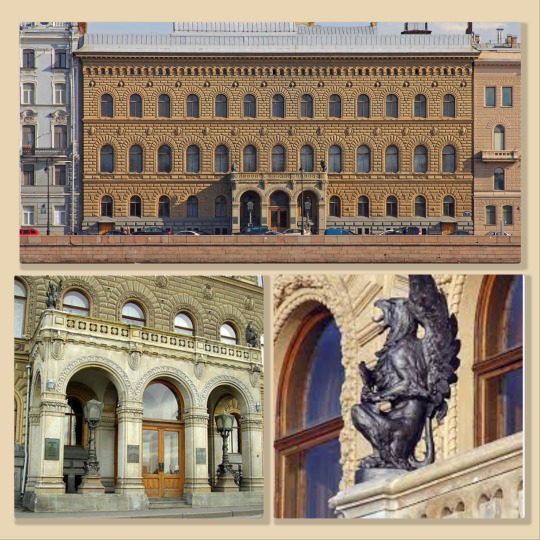
The Vladimir Palace
Grand Duke Vladimir Alexandrovich's Palace was the last imperial palace completed in Saint Petersburg. Building took place between 1867 and 1868, but decoration work continued for several years (until 1874). The Palace was blessed on the date the Grand Duke married Maria Pavlovna, and the couple moved right in. The palace's facade was done in the neo-Renaissance style; the interiors are in different styles: Neo-baroque, neo-rococo, neo-gothic, Russian, and “Moorish style.” The Vladimir Palace has 360 rooms.

A photograph of a staircase that has become iconic.
Today, the palace looks very much like it did when it was being inhabited by the Vladimirs. Many of the Grand Duke's exquisite collections of paintings, porcelains, etc., remain complete and undamaged.
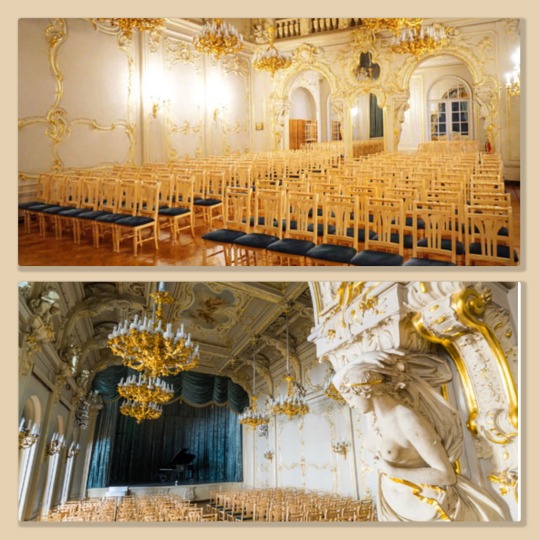
The photographs above show the palace's theater, where the Vladimirs held frequent concerts and recitals in honor of their guests.
The Vladimir Palace owes its excellent state of conservation to the fact that after the October Revolution, the palace was made the 'Academics' House' (Дом Учёных, named after Maxim Gorky); the building was frequented by academics and scientists who knew the historical value of the palace and its contents and thus treated their surroundings kindly. Consequently, its interior is better preserved than other Romanov family residences. Much attractive tiling and many internal architectural details have been retained. Not only have collections been maintained, but some have been expanded.

The picture below is the "oak room,". One can easily imagine a ball taking place in it.

Photographs of some of the sumptuous living spaces in the palace, including one of the library.
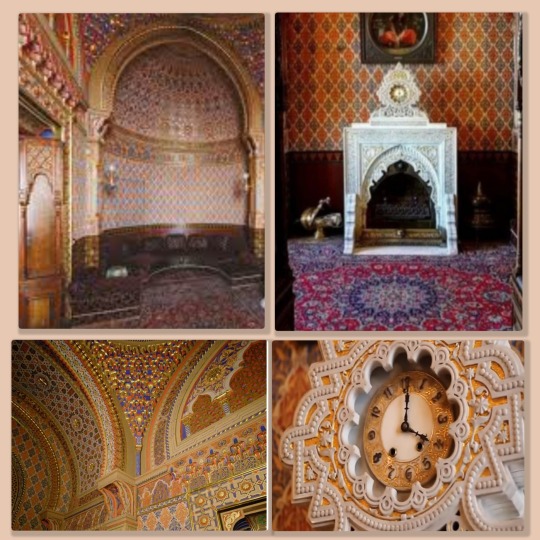
Photographs of the Grand Duchess Maria Pavlovna's famous Moorish boudoir. Notice the detailed tile work.
The Vladimir Palace is not a museum, but tours are given. It has become the meeting point of St. Petersburg’s social, cultural, intellectual, and scientific existence.
#russian history#romanov dynasty#imperial russia#Vladimir Palace#Grand Duke Vladimir Alexandrovich#Grand Duchess Maria Pavlovna the Elder.
19 notes
·
View notes
Text




Planet B - Maxim Gorki Theater, Berlin
trailer, teaser
8 notes
·
View notes
Text
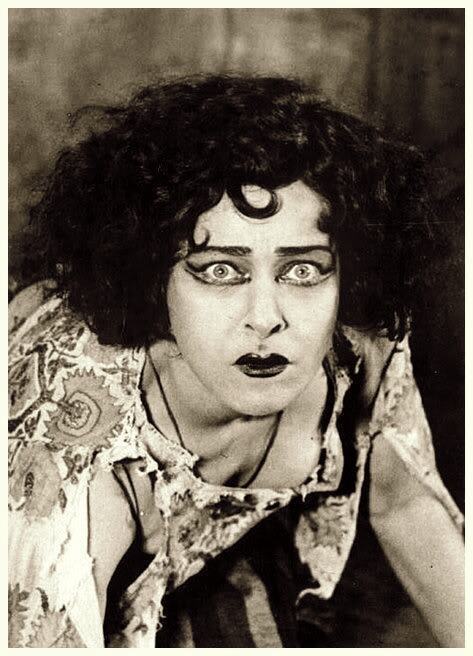
Silent film star Alla Nazimova.
A fascinating woman.
From her IMDB bio-
The grand, highly flamboyant Russian star Alla Nazimova of Hollywood silent films lived an equally grand, flamboyant life off-camera, though her legendary status has not held up as firmly as that of a Rudolph Valentino today.
Alla Nazimova was born Miriam Edez Adelaida Leventon in 1879, in Yalta, Crimea, in the Russian Empire, to Jewish parents, Sonya Horowitz and Yakov Leventon. She was the third child in an abusive, contentious household. Most of her sad childhood was spent in foster homes or in the care of other relatives and she showed a strong penchant for outrageous behavior to cope. Nazimova also showed a great aptitude for music at a young age and began violin lessons at age seven. She changed her name to Alla Nazimova when she began appearing on stage–her father insisted on it, as “performing” was not considered respectable at the time.
She began acting lessons at age 17 and joined Konstantin Stanislavski’s company of actors as a pupil of his “method style” at the Moscow Art Theatre. During that time she supported herself by being kept by rich, older men. A failed love affair led to her only marriage, to an acting student named Sergei Golovin, but they separated quickly. She grew discontented with Stanislavsky and later performed in repertory. She met the legendary Pavel Orlenev, a close friend of Anton Chekhov and Maxim Gorky, and entered into both a personal and professional relationship with him. They toured internationally throughout Europe with great success and came to New York in 1905, where Nazimova was saluted on Broadway for her definitive interpretations of Henrik Ibsen’s “Hedda Gabler” and “A Doll’s House.” Orlenev returned to Russia but Nazimova stayed.
She made her screen debut with War Brides (1916), which was initially a 35-minute play. By 1918 she was a box-office star for Metro Pictures and completed 11 films for the studio over a three-year period. A torrid, stylish and rather outré tragedienne who played exotic, liberal women confronted by great personal anguish, she earned personal successes as a reformed prostitute in Revelation (1918), a suicide in Toys of Fate (1918) and dual roles as half-sisters during the Boxer Rebellion in The Red Lantern (1919), not to mention the title role of Camille (1921) with Rudolph Valentino. At the same time she maintained a strong Broadway theatrical career.
In accordance with her rise in the film industry, she began producing her own efforts, which were bold and experimental–and monumental failures, although they are hailed as great artistic efforts today. Her Salomé (1922) was quite scandalous and deemed a failure at the time. The monetary losses she suffered as producer were astronomical. The Hays Code, which led to severe censorship in pictures, also led to her downfall, as did her outmoded acting style. She was forced to abandon films for the theater, scoring exceptionally well in Anton Chekhov’s “The Cherry Orchard.” She did return to films briefly in the 1940s in a variety of supporting roles, but she made these solely for the money.
Nazimova’s private life has long been the subject of industry gossip. As a Hollywood cover to her well-known bisexual lifestyle, she coexisted in a “marriage” with gay actor Charles Bryant for well over a decade. Her “Garden of Allah” home was the centerpiece for many glamorous private parties. She died in 1945.
9 notes
·
View notes
Text
Ukrainian icons of millions of linen knots in macrame
Ukrainian artist Vladimir Denshchikov creates these mind-blowing religious icons made by tying millions of linen thread knots, using a knot weaving technique called macrame.
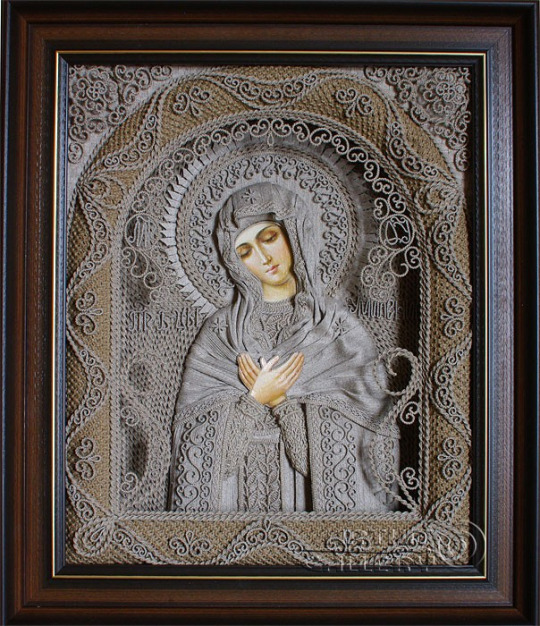
+++
Vladimir Denshchikov paints his icons with the blessing of the clergy; many of his artworks were blessed by the Metropolitan of Simferopol and the Crimea Archbishop Lazarus and his spiritual father, Rev. Sergius, arch-priest of the beacon church of Nicholas the Wonderworker. Before painting an icon, Vladimir Denshchikov keeps a fast.
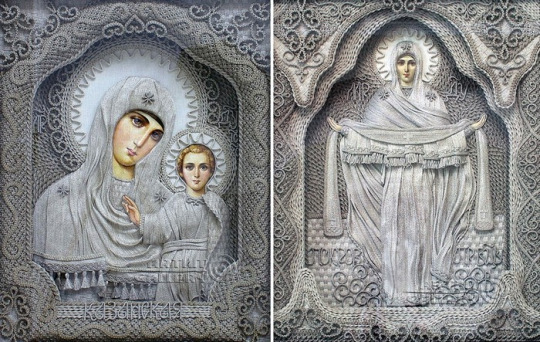
+++
An icon of 40 x 50 cm in size takes the artist from 3 to 6 months to execute. The saints’ faces are painted in oil on the linen canvass.
Vladimir Denshchikov’s icons are hand-knotted with linen threads (0.5-2 mm), with each knot being tied in hand, without needles and crotchets.
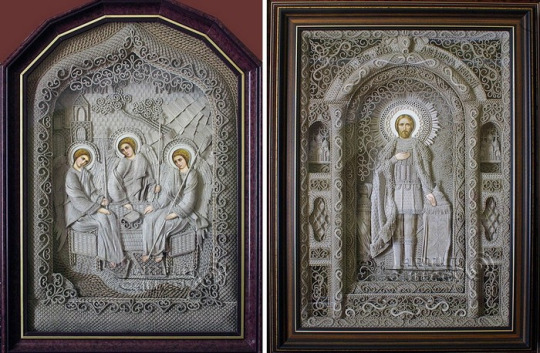
+++
Born on July 1, 1952 in Kiev, Vladimir Denshchikov graduated from the Kiev Theater University and went on to become an actor. He worked his way up to director and artistic director of the Simferopol Crimea Maxim Gorky Academic Russian Drama Theater, and since 2007 he has been teaching acting and directing at the Simferopol Institute of Culture.
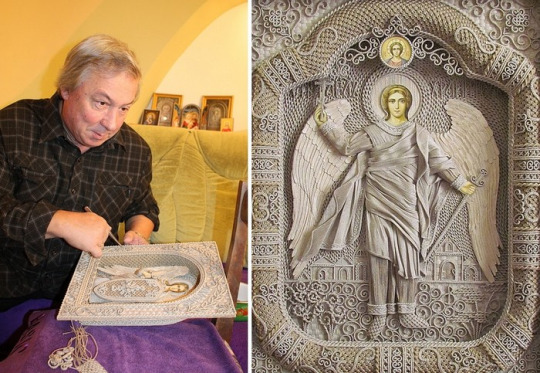
+++
Text and photos adapted from
https://4rtgallery.blogspot.com/2013/04/macrame-art-by-vladimir-denshchikov.html
and
https://www.odditycentral.com/pics/ukrainian-artist-creates-fantastic-religious-icons-from-millions-of-knots.html
and
http://www.arthit.ru/applied-art/0127/macrame-art.html
51 notes
·
View notes
Text
0 notes
Text
TdZ – Buch: Zeitgenoss*in Gorki, Zwischenrufe
1 note
·
View note
Photo
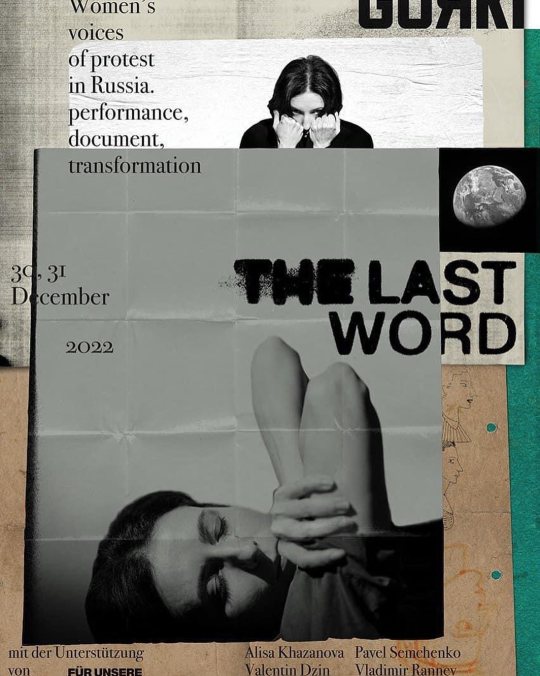
THE LAST WORD
Von Anna Narinskaya I Nach einer Idee von Alisa Khazanova
Regie Maxim Didenko
Maxim Gorki Theater - 2022
Costume design- Anis Kronidova
https://www.gorki.de/de/the-last-word
0 notes
Text

huch - die halle neben dem maxim gorki theater ist ja weg, herr hegel! (prisma‘s daily filter: archer)
(4.8.2022)
0 notes
Photo
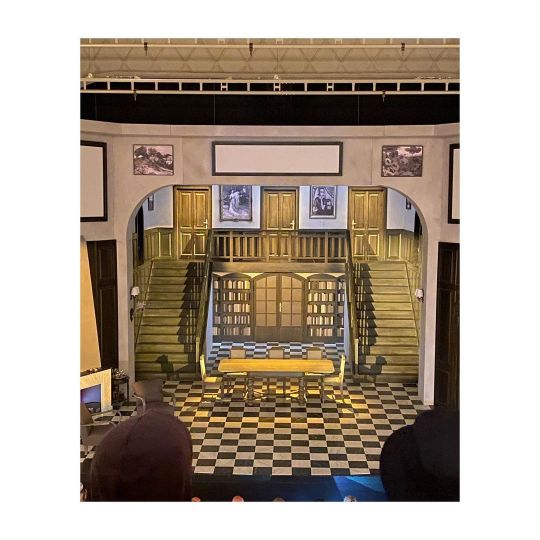
About last night… Went to see „Geschwister“ at @maxim_gorki_theater and spent the night talking about it with @wallcek and some other things. Highly recommend it. #berlin #maximgorkitheater #geschwister (at Maxim Gorki Theater) https://www.instagram.com/p/Ce_J17Qs3t_/?igshid=NGJjMDIxMWI=
0 notes
Text

Das Theater. / 12.01.2022
#Berlin#Berlin Mitte#Dorotheenstraße#Street Photography#Maxim Gorki Theater#Platz der Märzrevolution#2022#2022Januar#2022Januar12
5 notes
·
View notes
Text
August and September Concerts, Exhibition, Theater
August and September Concerts, Exhibition, Theater
Korhan Erel teamed up with Ayşe Cansu Tanrıkulu to compose music and sound for the theater piece “Krampus” directed and written by Isabella Sedlak and Ensemble at Maxim Gorki Theater. The play premiered on August 27 after a five-week period of rehearsals. Next shows are on September 16 and October 23.
Korhan played four shows with Klub Demboh and guests in August and September. The guests were…
View On WordPress
#baerenzwinger#Berlin#composition#electronic music#exhibition#experimental music#improvised music#improvised performance#Maxim Gorki Theater#music#performance#quartet#scarecrow#sound art#sound design#theater
0 notes
Photo

Seen in 2020:
The Lower Depths (Akira Kurosawa), 1957
#films#movies#stills#Akira Kurosawa#The Lower Depths#Toshiro Mifune#centennial#Isuzu Yamada#Japanese#1950s#literary#theater#adaptations#Maxim Gorky#seen in 2020#Criterion Channel
3 notes
·
View notes
